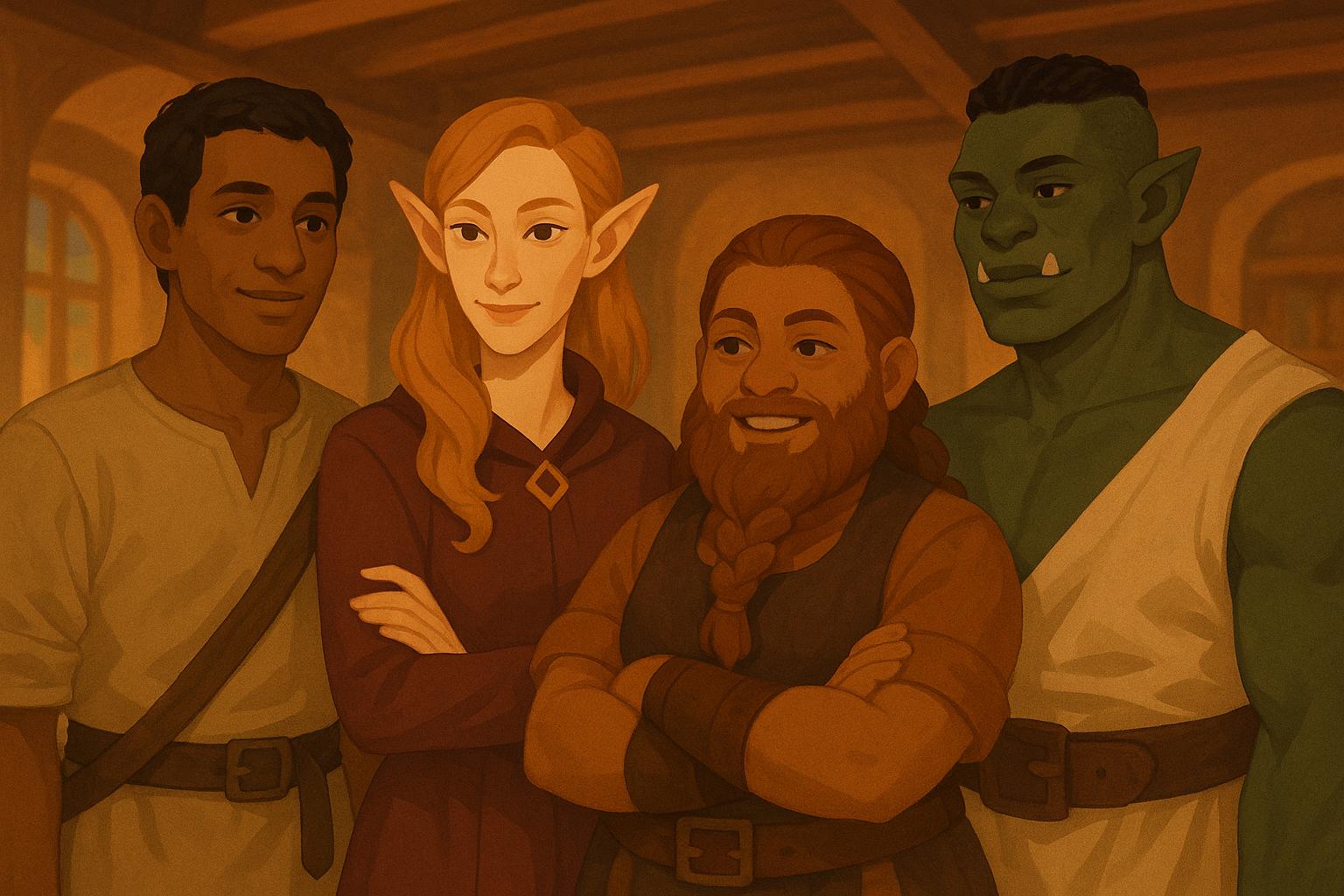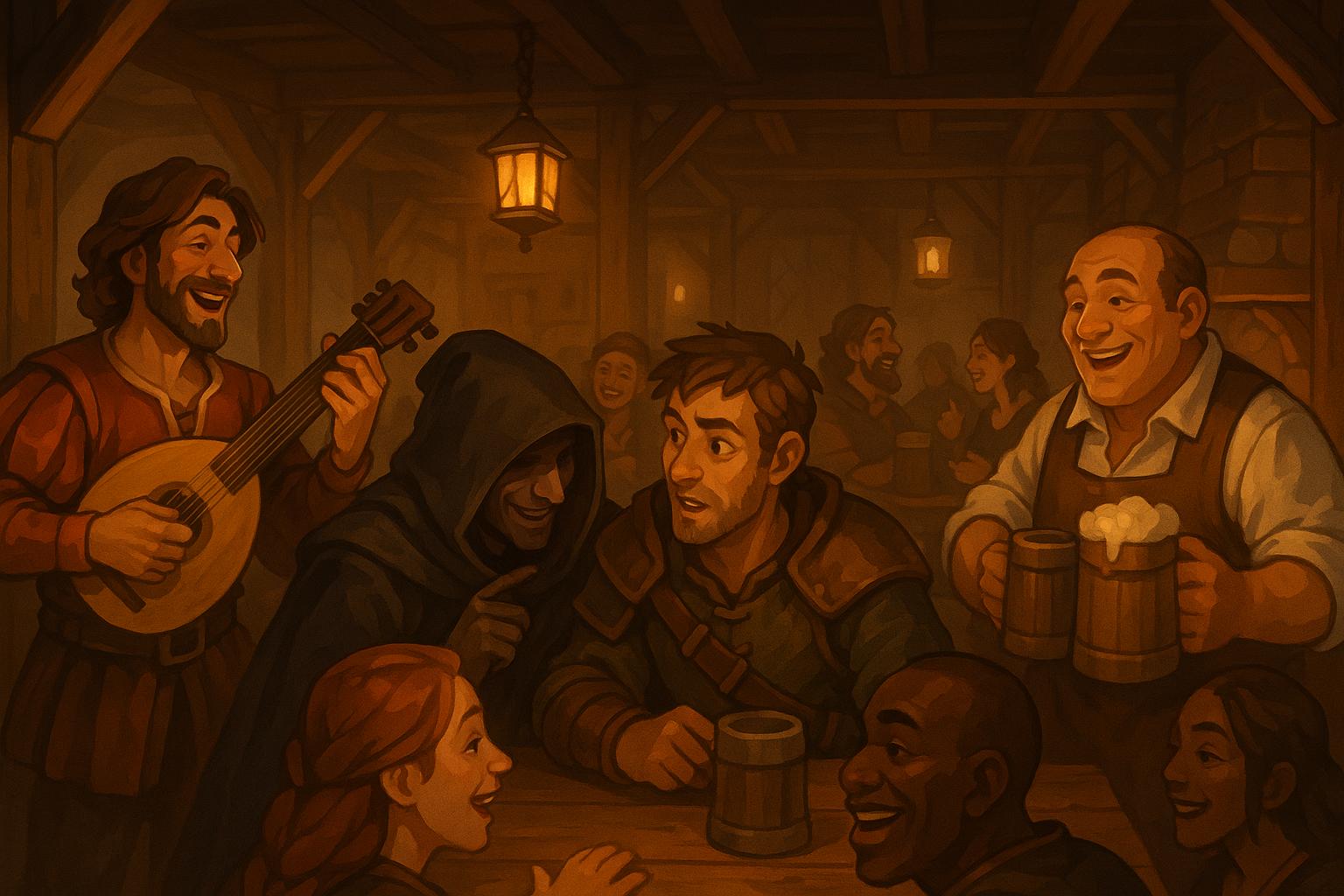Collaborative RPG worldbuilding is about creating game worlds together, not just leaving it to the Game Master (GM). This approach makes players co-creators, leading to stronger engagement and richer storytelling. Here’s a quick overview of what you’ll learn:
- What It Is: Players and GMs share worldbuilding responsibilities.
- Why It Matters: Less work for the GM, better player engagement, and diverse ideas.
- How to Start: Use tools like worldbuilding card decks or structured systems during session zero.
- Methods: Techniques like turn-based systems (e.g., Dawn of Worlds) or staged approaches (Halivar's World Creation Game) help organize the process.
- Diversity and Inclusion: Incorporate varied perspectives while avoiding stereotypes for a more immersive world.
- Tools: Combine physical tools (e.g., card decks) with digital platforms to streamline collaboration.
Quick Tip:
Start with a session zero to connect character backstories to the world and use tools like the Ultimate RPG Worldbuilding Deck for structured prompts. Together, you can build a dynamic and inclusive RPG setting that evolves with your group.
Why Collaborative World-Building is a Game Changer for Your TTRPG Game
Key Principles and Methods
Collaborative Worldbuilding Techniques
Dawn of Worlds showcases a turn-based system where players and GMs work together to shape the world. This approach works across different genres, from high fantasy to science fiction. While the open-ended nature of the game sparks creativity, having a structured plan ensures the world feels cohesive and well thought out.
A Staged Approach to World Creation
Halivar's World Creation Game takes a more structured route, dividing the process into distinct ages. Each age focuses on specific aspects of the world's development, helping groups create a detailed and logical history.
| Age | Focus | Key Elements |
|---|---|---|
| First Age | Elder Races | Ancient civilizations, mythical beings |
| Second Age | Lesser Races | Emerging cultures, shifts in power |
| Third Age | Age of Man | Modern societies, current conflicts |
This method ensures that each era builds on the one before it, creating a layered and engaging narrative. It’s a great way to add depth and continuity to your world’s story.
Embracing Diverse Perspectives
Games like Ironsworn and Good Society highlight the value of including different viewpoints in worldbuilding. These games use unique mechanics to bring varied ideas into the process, making the storytelling richer and more inclusive. Tools like the TTRPG Games Directory can also help ensure everyone’s voice is heard and represented.
Here are some strategies for weaving diverse perspectives into your world:
- Active Listening: Treat every contribution as important.
- Character Integration: Connect characters’ backstories to the world’s fabric.
- Cultural Exploration: Develop unique customs, traditions, and belief systems.
Another effective technique is using descriptive traits - players define the world with terms like mysterious, ancient, or chaotic. This sparks creativity and helps the group build a shared vision [1].
sbb-itb-b8b00a5
Tools and Resources for Worldbuilding
Worldbuilding Card Decks
The Ultimate RPG Worldbuilding Deck is a handy tool for creating worlds together. This deck includes structured prompts to help you build key elements like factions, landmarks, and hidden secrets. Each card introduces a themed idea, making it easy to combine them into unique settings and stories.
Here’s how you can use these decks effectively:
| Purpose | Card Type | How It Helps |
|---|---|---|
| Building the Setting | Location Cards | Design major landmarks and regions |
| Structuring Society | Faction Cards | Develop interconnected groups |
| Adding Mysteries | Secret Cards | Create conflicts and hidden stories |
| Shaping History | History Cards | Map out timelines and key events |
Card decks provide a hands-on and structured way to develop worlds. They’re especially useful when paired with other resources like RPG game directories for more inspiration.
RPG Game Directories
Digital tools play a big role in modern worldbuilding. For example, the TTRPG Games Directory (ttrpg-games.com) helps groups find games with mechanics that encourage shared storytelling. Browsing through this directory can spark ideas for settings and systems that promote collaboration.
Digital tools like collaborative documents and virtual tabletops also help teams stay organized and test their ideas during gameplay. These tools work well alongside traditional methods, offering a balance of structure and creativity.
"Combining physical tools like card decks with digital platforms creates a dynamic space for collaborative creation, blending traditional and modern methods seamlessly." [1]
Guidelines for Diverse Worldbuilding
Building Diverse Worlds
Creating inclusive RPG settings requires careful collaboration and thoughtful representation. Bluebeard's Bride is a standout example, offering a feminist reimagining of classic fairy tales. Similarly, Ehdrigohr showcases how integrating Indigenous cultures and mythologies can lead to immersive and meaningful gaming experiences.
Involving players from different backgrounds in the worldbuilding process ensures a richer and more inclusive narrative. Here are some key elements to consider:
| Aspect | Purpose | Implementation |
|---|---|---|
| Cultural Integration | Respectful representation | Weave diverse cultural elements thoughtfully |
| Player Input | Broader perspectives | Incorporate varied backstories and lived experiences |
| Setting Elements | Enhanced storytelling | Combine cultural influences with care and respect |
| Social Dynamics | Realistic relationships | Craft power structures that reflect complex hierarchies |
"Creating a safe space for storytelling is crucial. Game masters should establish clear guidelines for respectful communication, encourage open dialogue, and be prepared to address any discomfort or concerns that arise." [1]
While diversity adds depth to your world, steering clear of stereotypes ensures it remains genuine and respectful.
Avoiding Stereotypes in Storytelling
Strong worldbuilding flourishes when it moves beyond harmful tropes and clichés. Game masters play a vital role in guiding players to create characters that defy traditional views on gender, culture, and societal roles.
Here’s how to approach this:
- Research and Consultation: Dive into thorough research and engage with experts or community members to ensure cultural accuracy.
- Character Development: Build layered, well-rounded characters that go beyond stereotypes.
- World Structure: Design varied social systems inspired by real-world complexities, steering clear of oversimplifications.
Regular feedback sessions offer players a chance to discuss representation and propose changes. This collaborative input helps maintain an engaging and inclusive world.
"Diverse worldbuilding deepens immersion and fosters empathy by challenging assumptions and broadening perspectives." [2]
Conclusion: Making RPGs More Engaging
Key Takeaways
Collaborative worldbuilding adds depth to tabletop RPGs by strengthening connections between players and the world they create together. It blends structured methods with creative freedom, resulting in immersive settings. A well-planned session zero lays the groundwork by incorporating player ideas, practical tools, and varied viewpoints. Together, these elements create storytelling environments that grow and change with player involvement.
With these strategies, both players and GMs can actively build and explore their shared worlds.
Practical Steps for Players and GMs
To put collaborative worldbuilding into action, start with focused discussions during session zero to define the main elements of your world. The TTRPG Games Directory is a great place to find games that highlight collaborative storytelling and diverse narratives.
Here are two ways to get started right away:
- Use worldbuilding tools and guides to spark new ideas.
- Experiment with games designed around group storytelling and shared input.
As your group continues to create together, your collaborative world will naturally grow, leading to more engaging and unforgettable RPG adventures.


